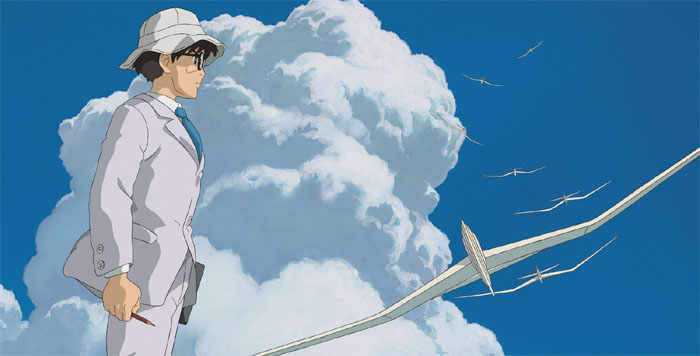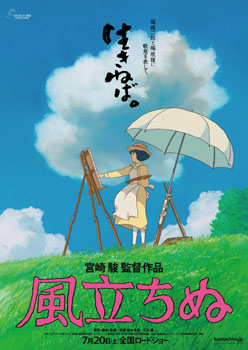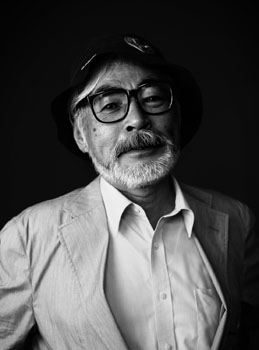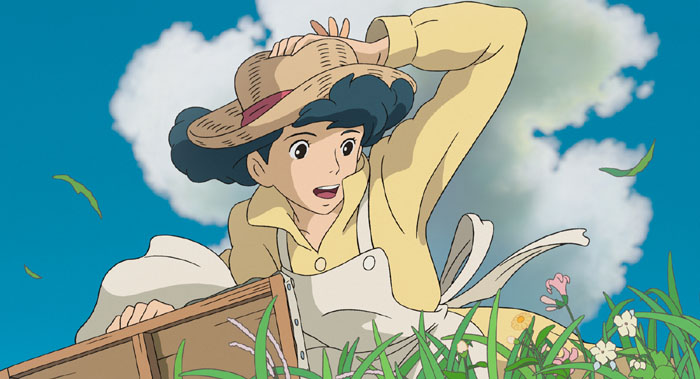 Jiro dreams of becoming a top aeronautical engineer in the Studio Ghibli animated feature THE WIND RISES from director Hayao Miyazaki. Image courtesy of Studio Ghibli and Wild Bunch. © 2013 Nibariki ? GNDHDDTK
Jiro dreams of becoming a top aeronautical engineer in the Studio Ghibli animated feature THE WIND RISES from director Hayao Miyazaki. Image courtesy of Studio Ghibli and Wild Bunch. © 2013 Nibariki ? GNDHDDTKNorth American Premiere for New Studio Ghibli Film on September 11th Source: Studio Ghibli, Wild Bunch Official Movie Site: kazetachinu.jp (Japan) Studio Ghibli`s THE WIND RISES (????, Kaze Tachinu, 2013), the new film by Hayao Miyazaki, will have its North American premiere at the Toronto International Film Festival on Wednesday, September 11, 2013.
SYNOPSIS Jiro dreams of flying and designing aircraft inspired by the famous Italian aeronautical engineer, Gianni Caproni. Near-sighted from a young age and therefore unable to become a pilot, in 1927 he began working in a leading Japanese aeronautical engineering company. His talent was soon recognized and grows until Jiro becomes one of the most successful aircraft designers in the world... DIRECTOR`S STATEMENT The designer of the fighter plane `Zero`, Jiro Horikoshi, and his predecessor, Italian Gianni Caproni, share the same aspiration, united by a friendship that goes beyond time and space. The two faced numerous setbacks as they devoted themselves entirely to the realization of their dreams of youth. In the Taisho period of Japanese history (1912-1926), a country boy decides to become an aeronautical engineer. Dreams of building an aircraft capable of twirling like a wonderful wind. Growing up, he went to Tokyo to study and become a top-level engineer for the enormous Japanese war industry. His talent flourishes, coming to create a wonderful plane that will leave a mark in aviation history: the Mitsubishi A6M1, better known as a combat aircraft `Zero`. For three years, starting from 1940, `Zero` was the best fighter aircraft in the world. The years during which our protagonist goes from childhood to adulthood are marked by a feeling of stasis: the Kanto earthquake of 1923, the Great Depression, unemployment, poverty and tuberculosis, revolution and fascism, suppression of freedom of speech, one war after another. Meanwhile, during the same period, popular culture flourishes; asserting modernism and nihilism, as well as hedonism. The poets, in their way, are victims of disease and death. Our protagonist Jiro is committed to designing airplanes while the Japanese Empire starts towards its destruction and definitive end. It`s the story of an individual devoted to his work, who has doggedly pursued his dream. The dreams contain an element of madness, and this "poisonous" aspect can not be hidden. Craving something too good can destroy. There can be a price to pay for approaching beauty. Jiro will be destroyed and defeated, his career as a designer lost, but he remains a man of great originality with an uncommon talent. The title THE WIND RISES is taken from a short story of the same name written by Tatsuo Hori. Hori had chosen a phrase from a poem by Paul Valéry, "Le vent if lève, il faut tenter de vivre" [The Graveyard by the Sea], and had it translated into Japanese: "Kaze tachinu, iza ikimeyamo (The wind rises. We must try to live)". Our film brings together Jiro Horikoshi and the writer Tatsuo Hori; two real people who lived in the same period, making it one individual, `Jiro`, our protagonist. It is an unusual work of absolute fiction, describing the Japanese youth of the 1930`s. The birth of the `Zero` fighter plane, and the meeting and separation of the young engineer Jiro and the beautiful and unfortunate Nahoko. This is our history. The good old Caproni, overcoming the barriers of space and time, will serve to add a little color to the story. ![]() -- Hayao Miyazaki HAYAO MIYAZAKI Hayao Miyazaki was born in 1941 in Tokyo. After graduating in political science and economics at Gakushuin University in 1963, he joined the Toei Animation Company. As in the case of his mentor Isao Takahata, this type of career is unusual for a degree in those fields. But as a university student, Miyazaki was passionate about children`s literature and read all kinds of national and international publication written for children.
-- Hayao Miyazaki HAYAO MIYAZAKI Hayao Miyazaki was born in 1941 in Tokyo. After graduating in political science and economics at Gakushuin University in 1963, he joined the Toei Animation Company. As in the case of his mentor Isao Takahata, this type of career is unusual for a degree in those fields. But as a university student, Miyazaki was passionate about children`s literature and read all kinds of national and international publication written for children.
Hayao Miyazaki is also a superb draftsman. As an animator, he was involved in the creation of numerous films and TV series, often in collaboration with Takahata. In 1978, he directed the TV series CONAN, THE BOY IN FUTURE (???????, Mirai Shoonen Konan) and. in 1979, the film THE CASTLE OF CAGLIOSTRO (????? ????????, Rupan Sansei: Kariosutoro no Shiro). At the beginning of the eighties, Miyazaki traveled to Los Angeles to study animation with the famous "Nine Old Men" of Walt Disney. One of his friends and students of those years is John Lasseter, founder and creative mind of Pixar Animation Studios and director of such films as TOY STORY, A BUG`S LIFE, TOY STORY 2 and CARS. During the same period, Miyazaki wrote and illustrated the acclaimed comic book series Nausicaä of the Valley of the Wind (????????, Kaze no Tani no Naushika, 1982). In 1985, he founded Studio Ghibli with Takahata. His SPIRITED AWAY (????????, Sen to Chihiro no Kamikakushi, 2001) would break all records at the Japanese box office and won a number of prizes and awards, including the Golden Bear at the Berlinale in 2002 and the Oscar for best animated film in 2003. Miyazaki`s fame is mainly due to his being a director of films for children. In 2004, HOWL`S MOVING CASTLE (???????, Hauru no Ugoku Shiro), based on the book by British author Diana Wynne Jones, received the Osella award at the Venice Film Festival. And at the Lido the following year, Miyazaki was honored with the Golden Lion for Lifetime Achievement. Among the other masterpieces created by the author are CASTLE IN THE SKY (????????, Tenkuu no Shiro Rapyuta, 1986), MY NEIGHBOR TOTORO (???????, Tonari no Totoro, 1988) KIKI`S DELIVERY SERVICE (??????, Majo no Takkyuubin, 1989), PORCO ROSSO (???, Kurenai no Buta, 1992) and PONYO (???????, Gake no Ue no Ponyo, 2008). Among the various activities of Hayao Miyazaki are the publication of several collections of poetry, essays and drawings and the design of several prestigious buildings, including the Ghibli Museum and Mitaka Inokashira Park in Tokyo. CREDITS Japanese Theatrical Release: July 20, 2013 International Premiere: September 1, 2013 (70th Venice International Film Festival) North American Premiere: September 11, 2013 (Toronto International Film Festival) Running Time: 126 minutes Rating: PG Principal Cast Jiro: Hideaki Anno Nahoko Satomi: Miori Takimoto Honjo: Hidetoshi Nishijima Kurokawa: Masahiko Nishimura Hattori: Jun Kunimura Mrs. Kurokawa: Shinobu Otake Giovanni Battista Caproni: Mansai Nomura Staff Director: Hayao Miyazaki Executive Producer: Koji Hoshino Producer: Toshio Suzuki Screenplay: Hayao Miyazaki Music: Joe Hisaishi Production Company: Studio Ghibli Inc. Domestic Distributor: Toho Co., Ltd. North American Distributor: Walt Disney Studios Pictures International Sales Agent: Wild Bunch
About Studio Ghibli
Studio Ghibli was founded in 1985 by animation directors Hayao Miyazaki and Isao Takahata and is one of the most successful and well-respected animation studios in the world. Cultivating a creative force of talented directors, animators, and storytellers under the revered brilliance of Miyazaki and Takahata, Studio Ghibli’s films have been praised for their originality, dazzling animation, and epic storytelling. The films have become a beloved part of Japanese popular culture, and have garnered worldwide acclaim from audiences and critics alike. Hayao Miyazaki’s SPIRITED AWAY won the Academy Award for Best Animated Feature in 2002 and in 2005 Miyazaki was named one of "the most influential people" by Time Magazine.




